Curious Kids is a series for children of all ages, where The Conversation asks experts to answer questions from kids. All questions are welcome: find out how to enter at the bottom of this article.
How do eyes grow? – Annette, age seven, Stratford-upon-Avon, UK
Thanks for this brilliant question, Annette. Human beings’ eyes are quite unusual, because they are almost full sized when we are born. They do grow a bit bigger – but only by a few millimetres. But that’s not all that happens – when we are very young, our brains also learn to make images from the messages it gets from our eyes, and that’s how we learn to see.
Let’s start at the beginning: before we are born, we grow inside our mum’s body. We start life being very tiny – about the size of the top of a pin, or a full stop in a book.
Even though we start out very small, we are made up of special tiny building blocks called cells.
Every day, the number of cells gets bigger and bigger, and different types of cell start to form as well.
The starting point
Each different type of cell is the starting point for the different parts of our bodies. So one type of cell might help to grow our ears, while another will help to grow our hearts, and so on.
There are three different types of cell that work to make our eyes. When we have been growing inside mum for about three weeks, our eyes start to be created.
After four weeks, special connectors called “nerves” start to grow, to connect our eyes with our brain. These connectors are very important, because they help our eyes to tell our brain about what we are seeing.
And by the time we have been growing inside mum for ten weeks, our eyes are fully formed, with all the parts they need in order to see.

At this stage, our whole body is about the size of a strawberry, so you can imagine how small our eyes must be. For the next 30 weeks or so, the baby will use energy from mum to grow bigger and bigger, until it is born.
Learning to see
When we are born, our eyes alone are about the size of a large raspberry. They don’t grow much bigger than that, and end up being about the size of a cherry.
In fact, when you think about how much bigger a grown up hand is than a baby’s hand, it’s clear that our eyes don’t have to grow very much at all, compared with the rest of our body.
What does change, though, is our sight. As soon as we open our eyes after we are born, they start to send signals along the nerves connecting to our brain.
But at first, we don’t see very well, and most things will look quite blurry. This is because our brain needs to learn how to turn information from our eyes into what we see.
As we get older, our vision gets better and better. When we are about eight weeks old, we can start to focus our eyes on the faces of people close to us. When we are three months old, we start to be able to follow things if they are moving around.
By five months old, we can see colours, and by the time we are three years old, we can see things just as clearly as most grown-ups.
It’s really important that we look after our eyes. We can do this by wearing sunglasses on bright days to protect our eyes from the sun, and by having our eyes checked over every year by an optometrist or eye doctor, so that we have clear sight long into adulthood.
Hello, curious kids! Have you got a question you’d like an expert to answer? Ask an adult to send your question to us. You can:
* Email your question to curiouskids@theconversation.com
* Tell us on Twitter by tagging @ConversationUK with the hashtag #curiouskids, or
* Message us on Facebook.

Please tell us your name, age and which town or city you live in. You can send an audio recording of your question too, if you want. Send as many questions as you like! We won’t be able to answer every question, but we will do our best.
More Curious Kids articles, written by academic experts:

